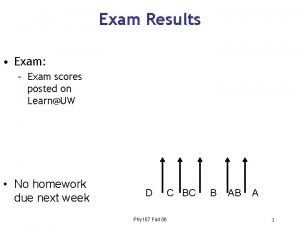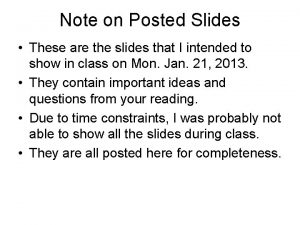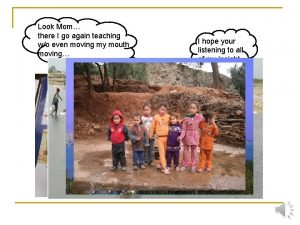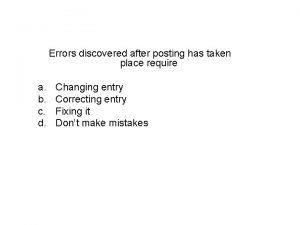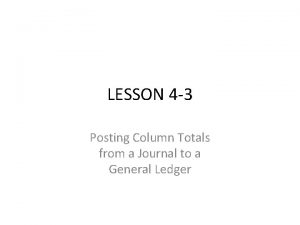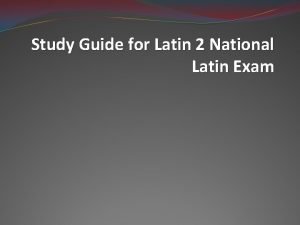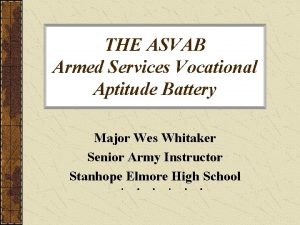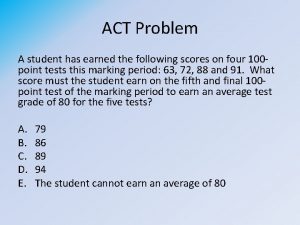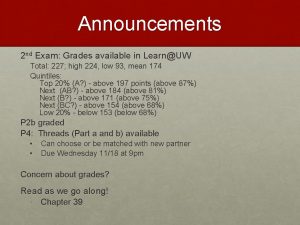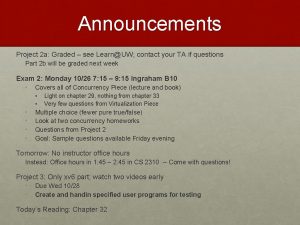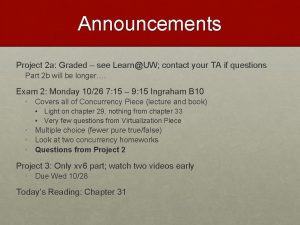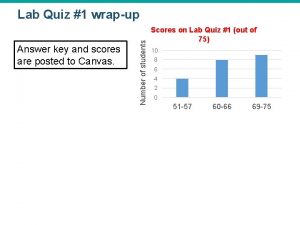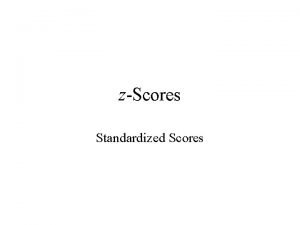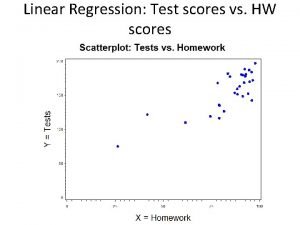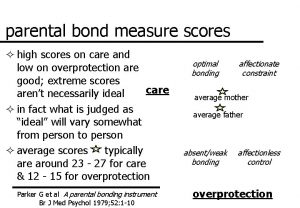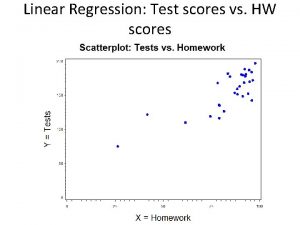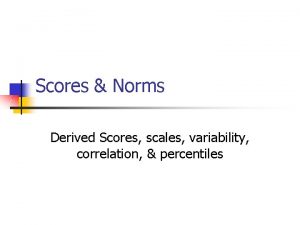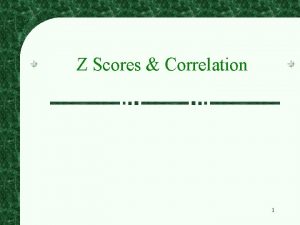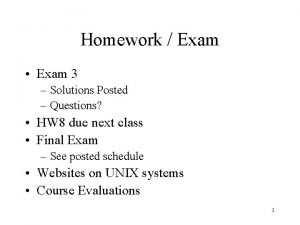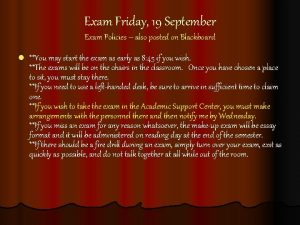Exam Results Exam Exam scores posted on LearnUW






























- Slides: 30

Exam Results • Exam: – Exam scores posted on Learn@UW • No homework due next week D C BC Phy 107 Fall 06 B AB A 1

Today: waves • Have studied Newton’s laws, motion of particles, momentum, energy, etc. • Laws for describing things that move. • Waves are a different type of object – They move (propagate), but in a different way • Examples: – – Waves on a rope Sound waves Water waves Stadium wave! Phy 107 Fall 06 2

Wave Motion • A wave is a type of motion – But unlike motion of particles • A propagating disturbance – The rope stays in one place – The disturbance moves down the rope Phy 107 Fall 06 3

What is moving? • Mechanical waves require: – Some source of disturbance – A medium that can be disturbed – Some physical connection between or mechanism though which adjacent portions of the medium influence each other – Waves move at a velocity determined by the medium • The disturbance in the medium moves through the medium. • Energy moves down the rope. Phy 107 Fall 06 4

Motion of a piece of the rope • As the wave passes through, a piece of the rope vibrates up and down. As the pulse passes, there is kinetic energy of motion. Phy 107 Fall 06 5

Energy transport • If rope section is not moving, kinetic energy is zero. • Determine motion by looking at rope position at two different times. Zero velocity Time=1. 0 sec Time=1. 1 Positive and negative velocities Phy 107 Fall 06 6

How does the wave travel • Energy is transmitted down the rope • Each little segment of rope at position x has some mass m(x), and moves at a velocity v(x), and has kinetic energy Phy 107 Fall 06 7

Waves on a whip The forward crack • The loop travels at velocity c, whereas a material point on top of the loop moves at velocity 2 c. Whip tapers from handle to tip, so that wave velocity increases. ‘Crack’ occurs as tip breaks sound barrier! Phy 107 Fall 06 8

Wave speed • The speed of sound is higher in solids than in gases – The molecules in a solid interact more strongly, elastic property larger • The speed is slower in liquids than in solids – Liquids are softer, elastic property smaller • Speed of waves on a string Tension Mass per unit length Phy 107 Fall 06 9

Waves can reflect • Whenever a traveling wave reaches a boundary, some or all of the wave is reflected • Like a particle, it bounces back. But… • When it is reflected from a fixed end, the wave is inverted Phy 107 Fall 06 10

Superposition of waves • Two pulses are traveling in opposite directions • The net displacement when they overlap is the sum of the displacements of the pulses • Note that the pulses are unchanged after the passing through each other Phy 107 Fall 06 11

Types of waves • Wave on a rope was a transverse wave • Transverse wave: each piece of the medium moves perpendicular to the wave propagation direction Phy 107 Fall 06 12

Longitudinal Waves • In a longitudinal wave, the elements of the medium undergo displacements parallel to the motion of the wave • A longitudinal wave is also called a compression wave Phy 107 Fall 06 13

Graph of longitudinal wave • A longitudinal wave can also be represented as a graph • Compressions correspond to crests and stretches correspond to troughs Phy 107 Fall 06 14

Sound waves • The medium transporting the wave is the air • The air is locally compressed, then compresses air next to it, etc. • The sound velocity depends on – Mass density of the air (mass per unit volume) – and the ‘compressibility’ of the air Phy 107 Fall 06 15

Producing a Sound Wave • Sound waves are longitudinal waves traveling through a medium • A tuning fork can be used as an example of producing a sound wave • As the tines vibrate, they disturb the air near them • As the tine swings to the right, it forces the air molecules near it closer together • This produces a high density area in the air – Area of compression • Tine swings to left – Area of rarefaction Phy 107 Fall 06 16

Sound from a Tuning Fork • As the tuning fork continues to vibrate, a succession of compressions and rarefactions spread out from the fork • A sinusoidal curve can be used to represent the longitudinal wave – Crests correspond to compressions and troughs to rarefactions Phy 107 Fall 06 17

Continuous wave • Can generate a wave that occupies all of the rope by continuing to shake the end up and down. • This wave is present throughout the length of the rope, but also continually moves. • Can think of a wave source continually emitting waves along the string. • This is sort of like a string of pulses Phy 107 Fall 06 18

Waveform – A Picture of a Wave • Just like the pulse, a continuous wave moves. • The red curve is a “snapshot” of the wave at some instant in time • The blue curve is later in time • A is a crest of the wave • B is a trough of the wave Phy 107 Fall 06 19

Description of a Wave • Amplitude is the maximum displacement of string above the equilibrium position Amplitude • Wavelength, , is the distance between two successive points that behave identically • For instance, the distance between two crests Phy 107 Fall 06 20

Period, frequency and velocity of a wave • Period: time required to complete one cycle – Unit = seconds • Frequency = 1/Period = rate at which cycles are completed – Units are cycles/sec = Hertz • Period wavelength and velocity are related – If the wave travels one wavelength in the time of one period then • velocity = wavelength/period Phy 107 Fall 06 21

Equation form • Velocity = Wavelength / Period • v = / T, or v = f • f = Frequency = 1 / Period = 1/T Phy 107 Fall 06 22

Periodic waves • Shake one end of a string up and down with period T (frequency f=1/T). The height (up or down) is the amplitude. • Peaks move at speed v so are separated by distance (wavelength) =v. T = v/f. • The wave can shake a fixed object with that frequency. Phy 107 Fall 06 23

Examples • The speed of sound in air is 340 m/s. • A source period of 1 Hz=1/s produces a wavelength of =v/f= 340 m • A string vibrating at frequency f= 340 Hz produces a wavelength =v/f = 1 m Phy 107 Fall 06 24

Question • A sound wave is traveling through air when in encounters a large helium-filled balloon. The sound velocity inside the balloon is greater than in the air. Compare the wavelength of the sound wave inside and outside the balloon. A. inside= outside B. inside> outside 0 1 C. inside< outside The frequency inside the balloon is the same as outside. Use = v / f to find that the wavelength is less Phy 107 Fall 06 =v/f 25

Wave quantities summary o Time of one COMPLETE up and down motion – one period T = 1/f – one wavelength in one period o Velocity of disturbance (wave or phase) velocity o Particles don’t move with v (only up-and-down) or (back and forth) v = f • v depends only on properties of “medium” Phy 107 Fall 06 26

Water waves? • Water waves occur on the surface. They are a kind of transverse wave. On the sun On Earth Phy 107 Fall 06 27

Surface water waves • Surface water waves produced by wind. • The wave travels with some speed, but the water does not! Phy 107 Fall 06 28

Water’s Motion I The wave travels while the water circles! Phy 107 Fall 06 29

Water’s Motion • Circling strongest at surface • Weak ~ 1/2 wavelength deep Phy 107 Fall 06 30
 Learnuw
Learnuw Learnuw
Learnuw Typologies are nominal composite measures
Typologies are nominal composite measures Nmcbbhp
Nmcbbhp A food handler drops the end of a hose into a mop bucket
A food handler drops the end of a hose into a mop bucket Organisation chart of front office
Organisation chart of front office Impulse examples
Impulse examples Look mom i posted it again
Look mom i posted it again What do errors discovered after posting require?
What do errors discovered after posting require? Signage posted at a handwashing station must include
Signage posted at a handwashing station must include Which column totals of a journal are posted?
Which column totals of a journal are posted? Febadvisor
Febadvisor Csca exam
Csca exam Fe exam results wednesday
Fe exam results wednesday Itec exam results
Itec exam results A prayer before a test or exam
A prayer before a test or exam National latin exam results
National latin exam results Esg relevance scores
Esg relevance scores Pact scores
Pact scores Reading counts levels
Reading counts levels Volleyball score sheet high school
Volleyball score sheet high school Norm referenced and criterion referenced
Norm referenced and criterion referenced Brigance iii
Brigance iii Fldoe vam scores by teacher
Fldoe vam scores by teacher Asvab average scores
Asvab average scores Finding z-score for a percentile
Finding z-score for a percentile Wisc-iv scores
Wisc-iv scores Integrated quality management system in education
Integrated quality management system in education Oxfordenglishtesting answers
Oxfordenglishtesting answers Dot
Dot A student has earned the following scores
A student has earned the following scores
